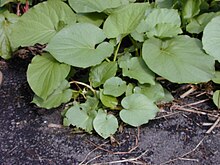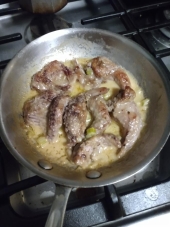The first tip is that beans will cook much faster if they are from the most recent harvest so less than a year old. They get drier and tougher as time goes by so need longer to cook. I often do a 6-8 hour overnight soak, pour off that water, and add new water before running them about 20 minutes in my pressure cooker. I know they are ready because my house fills with the smell of cooked beans so that's when I turn off the pressure cooker (mine is a classic type and I use LP for fueling the stove it sits on). I hear those new-fangled insta pot things work as well, but my electricity has a tendency to go out whenever it rains so I don't have a ton of electrical appliances. I usually cook a kilo of dried beans at a time and once cooled store and freeze them and my family will eat them over the
course of a month. I rotate different kinds of beans cooked each week, so there are usually red, black, white, and garbanzos frozen in about quart-size portions in my freezer.
Now for seasoning black beans to eat.
The most basic is re-fried. The secret here is onion. Slice white onion and caramelize it in plenty of oil in a pot that evenly distributes heat, could be clay, cast iron, or those double bottom stainless steel pots. Once the onion is burnt, remove it from the oil and discard it. Then add your cooked beans to your onion-flavored oil and start mashing. Salt to taste, if possible use a land mined mineral salt that has trace carbons in it rather than refined salt. If that is not possible, substitute baking soda for 1/4 of your salt.
I live about 30 minutes from where salt is mined, here it's called "sal blanca" but around Mexico
City it's known as
Tequesquite As you can see in the link its mainly sodium bicarbonate and sodium chloride, but also has traces of potassium and other elements. And it really is that secret ingredient that keeps you from reproducing the fabulous food you had in Mexico. It is also the KEY for cooking with nopales (prickly pear pads) and making raw green salsa.
Whole black beans with
Epazote :max_bytes(150000):strip_icc()/what-is-epazote-4126810_color-16bfc7c768274085b756f088c0db8420.png)
In a small casserole dish put just a dollop of cooking oil, slice up onion tops, and add them to the casserole, as they start to look half cooked add the cooked beans with their liquid. Then add fresh or dried epazote. If it's dry, I prefer to crumble it, if it's fresh you can add whole leaves. Then salt, in this case, if you have the mineral salt, you add half that and half table salt. So if not reduce the baking soda to 1/8 of the total salt content.
Black beans with
Hierba Santa 
In a small casserole dish put just a dollop of cooking oil, add cooked black beans, take dried heirba santa (one of those herbs whose flavor intensifies when dried) and grind it between your hands so it falls as a powder into the beans. Salt with table salt. Hierba santa is particularly good with the smoky taste of beans cooked over a mesquite fire.
Black beans with avocado leaf and chile.
In a casserole dish lightly fry onion, turn down the heat and add black beans, five or so dried avocado leaves, and three
guajillo chilis my sisters-in-law insist you need to always use chilis in odd numbers! in all your cooking and that way, you won't get that overpowered reaction some cooks get. Salt with the 1/8th baking soda blend if you don't have mineral salt. Bring to a simmer, then blend. You can transfer this to a blender, which is the most common, mash it in the casserole, which will leave hard bits for the avocado leaves and chiles. I've found if you have a submersion blender in the casserole is the very best thing for this dish, unfortunately, I don't have one at home, but when I make this I wish I did.











